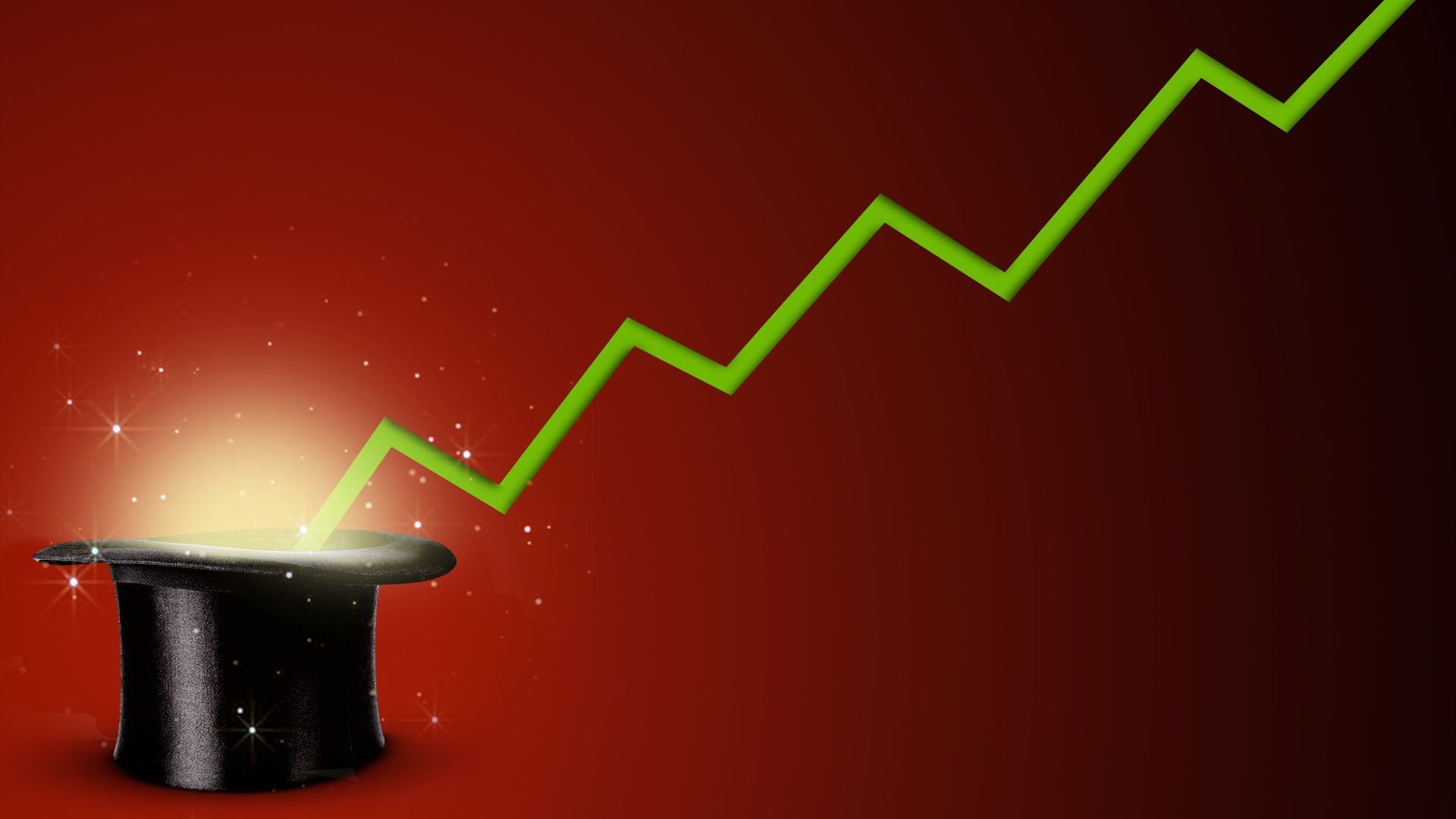| | | | | | | Presented By OurCrowd | | | | Axios Markets | | By Sam Ro ·Jul 01, 2021 | | Today's newsletter is 1,096 words, 4 minutes. 💬 of the day: "As consumers were home, they had more time to prepare breakfast and you saw things like eggs and pancakes grow more quickly than cereal." - Jonathon Nudi, General Mills executive | | | | | | 1 big thing: The incredible U.S. stock market |  | | | Illustration: Aïda Amer/Axios | | | | Give it up for the U.S. stock market. The S&P 500 has surged 14.4% from the beginning of the year through June 30, marking one of the strongest first halves of the year in history. Why it matters: So far 2021 has been riddled with eye-popping moves in a handful of buzzy assets that grabbed everyone's attention. And yet the stodgy U.S. stock market, propelled by booming earnings, has quietly delivered a fortune for investors. Yes, but: None of those come close to having the influence of the stock market. - The S&P 500 alone consists of over $36 trillion worth of companies, according to S&P Dow Jones Indices analyst Howard Silverblatt.
By the numbers: The S&P has generated better returns only 16 other times since 1950, LPL Financial's Ryan Detrick observed. - On average, it gained another 9.7% in the next six months.
- And, it delivered positive returns in 12 of those 16 cases.
What they're saying: "Strong equity markets tend to stay strong," Fundstrat Global Advisors' Tom Lee tells Axios. - "This makes sense in today's context given the robust economic recovery plus pent-up demand plus substantial corporate operating leverage. This is a formula for markets to surprise to the upside."
Be smart: Assuming history is indeed a guide, then the stock market could be due for a 10% pullback in the coming months. - All of that said, historical performance is no guarantee of future results.
|     | | | | | | Bonus chart: Don't call it a bubble |  Data: YCharts; Chart: Axios Visuals Think that's a stock market bubble? If not, great. We'll move on. Try tweeting it out to your followers to see what they have to say. Tag me @SamRo. If you want me to look into it, email me at sam.ro@axios.com. |     | | | | | | 2. Catch up quick | | Manufacturing activity growth decelerated in China and Japan in June. (Reuters) Krispy Kreme priced its IPO at $17 a share, well below its expected range of $21 to $24 a share. (MarketWatch) NCAA athletes can now earn money from their name, image and likeness. (Axios) |     | | | | | | A message from OurCrowd | | Digitized scents are reimagining the billion dollar fragrance market | | |  | | | | Moodify's patented technology creates advanced functional scents that generate a behavioral response, on-demand. Improve performance, enhance well-being, or eliminate the perception of bad odors––this is the future of fragrance. Explore Moodify's investment potential at OurCrowd. | | | | | | 3. Home sales have a pulse 🏚 |  New housing market reports suggest home sales are about to turn higher again. Why it matters: Even though average home prices continue to surge, the number of new and existing homes sold has been falling for months. Driving the news: Pending home sales – or homes under contract to be sold – unexpectedly jumped 8% in May, the National Association of Realtors revealed Wednesday. - "Pending home sales usually lead existing home sales by one or two months, so we likely will see existing home sales move higher in upcoming reports," JPMorgan economist Daniel Silver wrote.
- Separately, a report from Realtor.com found new listings in June jumped 10.9% from May.
What they're saying: "The issue for home sales remains tight inventories and a lagging supply response that is boosting prices," High Frequency Economics' Rubeela Farooqi said in an email. "But record high prices are likely an incentive for sellers to come to market." - Farooqi added that buyers have also been motivated by low mortgage rates, which some argue is thanks to the Fed.
Be smart: These two reports are not enough to confirm the downward trend of sales has reversed. |     | | | | | | 4. Workers are overcoming COVID fears |  COVID-19 fears are receding in the U.S., and this trend will have more and more Americans returning to work. Why it matters: A slew of factors have kept Americans on the sidelines despite robust demand for workers, leading to labor shortages and inflation in some categories. By the numbers: Since June 2020, the Census' Household Pulse Survey has been keeping a tally of those not working because they were "concerned about getting or spreading the coronavirus." - This number peaked at 6.24 million in early July 2020 but has been trending lower ever since. As of June 21, 2021, it was sitting at 3.05 million.
- For context, there were 7.6 million fewer Americans employed as of May than there were before the pandemic.
Many are quick to argue that the availability of enhanced unemployment insurance benefits is a major cause of labor shortages. But, but, but: "There just isn't strong evidence to suggest that enhanced jobless benefits are a major drag on the jobs recovery," Oxford Economics' Oren Klachkin tells Axios. - In a research note to clients, Klachkin observed "a tenuous relationship between changes in the number of people receiving supplemental jobless benefits and the number of people sending out resumes or filling out job applications."
- Recent studies from the San Francisco Fed and Indeed Hiring Lab confirm as much.
- "Health conditions are the most important factor for labor market healing," Klachkin
The big picture: "People are feeling safer about returning to work, which should help businesses staff-up to meet the tremendous demand we're seeing right now," Wells Fargo senior economist Sarah House tells Axios. |     | | | | | | 5. Robinhood has been bad |  | | | Illustration: Sarah Grillo/Axios | | | | Robinhood lied to its customers, costing them millions of dollars and breaking numerous rules, according to a blockbuster disciplinary action revealed by the Financial Industry Regulatory Authority, the brokerage's chief regulator, Axios' Felix Salmon writes. Why it matters: Robinhood burst onto a relatively sleepy discount-brokerage scene by offering disruptive mobile-native free stock trading. Finra's complaint, coupled with a record $70 million in fines and restitution, reveals the degree to which Robinhood failed at core components of what a brokerage must be able to do. What they're saying: To settle the investigation, Robinhood neither admitted nor denied the charges, but consented to the entry of Finra's findings. What they found: Robinhood inflicted "widespread and significant harm" on "millions of customers who received false or misleading information," per Finra. - Robinhood showed false cash balances to customers, sometimes showing negative balances that were twice the real balance. Historical account balance data was also false.
- The statements made to customers about options trading were regularly false.
- Robinhood's "option account approval bots" regularly approved red-flagged customers for options trading, even in situations when the company's own policies barred such approvals.
- Robinhood approved account opening requests even when the customer's purported Social Security number belonged to a person who was deceased.
- Robinhood outsourced the maintenance of its technology to its unregulated parent company, despite two warnings from Finra that the technology needed to be better supervised. The result was major outages that rendered customers incapable of accessing their accounts.
- Robinhood sent false margin calls to 84,100 customers, causing more than 25,000 of them to sell stocks when they didn't need to and thereby lose money.
What's next: Robinhood is one of the most hotly anticipated IPOs of 2021, but the date of the offering keeps on getting pushed back. Go deeper. |     | | | | | | A message from OurCrowd | | Software-created scent is revolutionizing the fragrance industry | | |  | | | | Invest in the next great fragrance innovation at OurCrowd. Moodify leverages 15 years of academic research to create scents that help improve mental performance, well-being, and more––altering the multi-billion dollar fragrance industry. Explore Moodify's investment potential. | | |  | | It'll help you deliver employee communications more effectively. | | | | | | Axios thanks our partners for supporting our newsletters. If you're interested in advertising, learn more here.
Sponsorship has no influence on editorial content. Axios, 3100 Clarendon Blvd, Suite 1300, Arlington VA 22201 | | | You received this email because you signed up for newsletters from Axios.
Change your preferences or unsubscribe here. | | | Was this email forwarded to you?
Sign up now to get Axios in your inbox. | | | | Follow Axios on social media:    | | | | | |
Post a Comment
0Comments